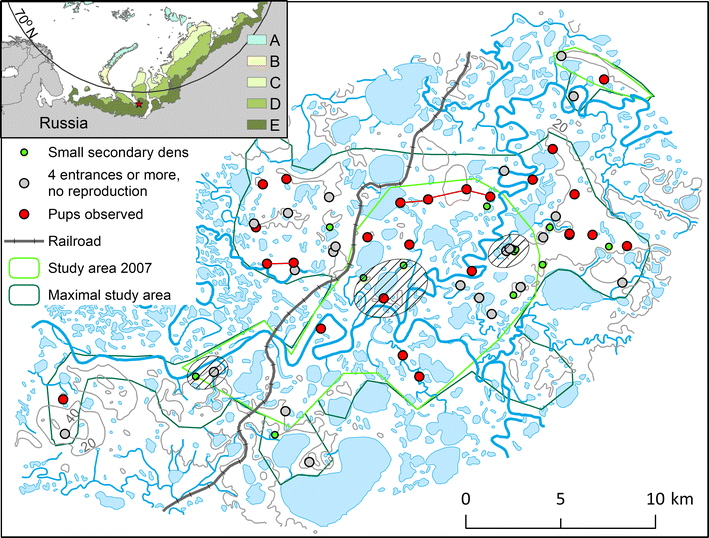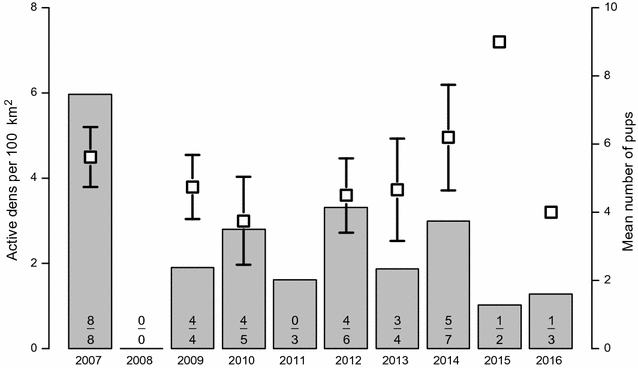Vole abundance and reindeer carcasses determine breeding activity of Arctic foxes in low Arctic Yamal, Russia
- PMID: 28915877
- PMCID: PMC5602845
- DOI: 10.1186/s12898-017-0142-z
Vole abundance and reindeer carcasses determine breeding activity of Arctic foxes in low Arctic Yamal, Russia
Abstract
Background: High latitude ecosystems are at present changing rapidly under the influence of climate warming, and specialized Arctic species at the southern margin of the Arctic may be particularly affected. The Arctic fox (Vulpes lagopus), a small mammalian predator endemic to northern tundra areas, is able to exploit different resources in the context of varying tundra ecosystems. Although generally widespread, it is critically endangered in subarctic Fennoscandia, where a fading out of the characteristic lemming cycles and competition with abundant red foxes have been identified as main threats. We studied an Arctic fox population at the Erkuta Tundra Monitoring site in low Arctic Yamal (Russia) during 10 years in order to determine which resources support the breeding activity in this population. In the study area, lemmings have been rare during the last 15 years and red foxes are nearly absent, creating an interesting contrast to the situation in Fennoscandia.
Results: Arctic fox was breeding in nine of the 10 years of the study. The number of active dens was on average 2.6 (range 0-6) per 100 km2 and increased with small rodent abundance. It was also higher after winters with many reindeer carcasses, which occurred when mortality was unusually high due to icy pastures following rain-on-snow events. Average litter size was 5.2 (SD = 2.1). Scat dissection suggested that small rodents (mostly Microtus spp.) were the most important prey category. Prey remains observed at dens show that birds, notably waterfowl, were also an important resource in summer.
Conclusions: The Arctic fox in southern Yamal, which is part of a species-rich low Arctic food web, seems at present able to cope with a state shift of the small rodent community from high amplitude cyclicity with lemming dominated peaks, to a vole community with low amplitude fluctuations. The estimated breeding parameters characterized the population as intermediate between the lemming fox and the coastal fox ecotype. Only continued ecosystem-based monitoring will reveal their fate in a changing tundra ecosystem.
Keywords: Diet; Food web; Numerical response; Reindeer carcasses; Small rodent community; Vole cycle; Vulpes lagopus.
Figures





Similar articles
-
Predator behaviour and predation risk in the heterogeneous Arctic environment.J Anim Ecol. 2008 May;77(3):439-47. doi: 10.1111/j.1365-2656.2008.01354.x. Epub 2008 Jan 29. J Anim Ecol. 2008. PMID: 18248387
-
Flexibility in a changing arctic food web: Can rough-legged buzzards cope with changing small rodent communities?Glob Chang Biol. 2019 Nov;25(11):3669-3679. doi: 10.1111/gcb.14790. Epub 2019 Sep 11. Glob Chang Biol. 2019. PMID: 31390125
-
Interference in the tundra predator guild studied using local ecological knowledge.Oecologia. 2016 Apr;180(4):1195-203. doi: 10.1007/s00442-015-3521-1. Epub 2015 Dec 19. Oecologia. 2016. PMID: 26686344
-
Effects on the structure of Arctic ecosystems in the short- and long-term perspectives.Ambio. 2004 Nov;33(7):436-47. doi: 10.1579/0044-7447-33.7.436. Ambio. 2004. PMID: 15573571 Review.
-
Cystic echinococcosis in the Arctic and Sub-Arctic.Parasitology. 2003;127 Suppl:S73-85. doi: 10.1017/s0031182003003664. Parasitology. 2003. PMID: 15027606 Review.
Cited by
-
Issues of under-representation in quantitative DNA metabarcoding weaken the inference about diet of the tundra vole Microtus oeconomus.PeerJ. 2021 Aug 26;9:e11936. doi: 10.7717/peerj.11936. eCollection 2021. PeerJ. 2021. PMID: 34527438 Free PMC article.
-
An ecosystem-wide reproductive failure with more snow in the Arctic.PLoS Biol. 2019 Oct 15;17(10):e3000392. doi: 10.1371/journal.pbio.3000392. eCollection 2019 Oct. PLoS Biol. 2019. PMID: 31613872 Free PMC article.
-
Large-scale changes in marine and terrestrial environments drive the population dynamics of long-tailed ducks breeding in Siberia.Sci Rep. 2022 Jul 19;12(1):12355. doi: 10.1038/s41598-022-16166-7. Sci Rep. 2022. PMID: 35853919 Free PMC article.
-
Effects of resource availability and interspecific interactions on Arctic and red foxes' winter use of ungulate carrion in the Fennoscandian low-Arctic tundra.Ecol Evol. 2024 Apr 1;14(4):e11150. doi: 10.1002/ece3.11150. eCollection 2024 Apr. Ecol Evol. 2024. PMID: 38571799 Free PMC article.
-
The impact of industrial pollution on the populations of small mammals in Northern Kazakhstan.Environ Sci Pollut Res Int. 2023 Apr;30(17):49980-49991. doi: 10.1007/s11356-023-25836-6. Epub 2023 Feb 14. Environ Sci Pollut Res Int. 2023. Retraction in: Environ Sci Pollut Res Int. 2024 Mar;31(15):23285. doi: 10.1007/s11356-024-32823-y. PMID: 36787073 Retracted.
References
-
- Ims RA, Ehrich D, Forbes BC, Huntley B, Walker DA, Wookey PA, Berteaux D, Bhatt US, Bråthen KA, Edwards ME, et al. Terrestrial ecosystems. In: Meltofte H, et al., editors. Arctic biodiversity assessment status and trends in Arctic biodiversity. Akureyri: Conservation of Arctic Flora and Fauna; 2013.
-
- Walker DA, Raynolds MK, Daniels FJA, Einarsson E, Elvebakk A, Gould WA, Katenin AE, Kholod SS, Markon CJ, Melnikov ES, et al. The circumpolar Arctic vegetation map. J Veg Sci. 2005;16:267–282. doi: 10.1111/j.1654-1103.2005.tb02365.x. - DOI
-
- Hansen BB, Isaksen K, Benestad RE, Kohler J, Pedersen ÅØ, Loe LE, Coulson SJ, Larsen JO, Varpe Ø. Warmer and wetter winters: characteristics and implications of an extreme weather event in the high Arctic. Environ Res Lett. 2014;9(11):114201. doi: 10.1088/1748-9326/9/11/114021. - DOI
-
- Ims RA, Killengreen ST, Ehrich D, Flagstad Ø, Hamel S, Henden J-A, Jensvoll I, Yoccoz NG. Ecosystem drivers of an Arctic fox population at the western fringe of the Eurasian Arctic. Polar Res. 2017;36:8. doi: 10.1080/17518369.2017.1323621. - DOI
Publication types
MeSH terms
LinkOut - more resources
Full Text Sources
Other Literature Sources
Miscellaneous

